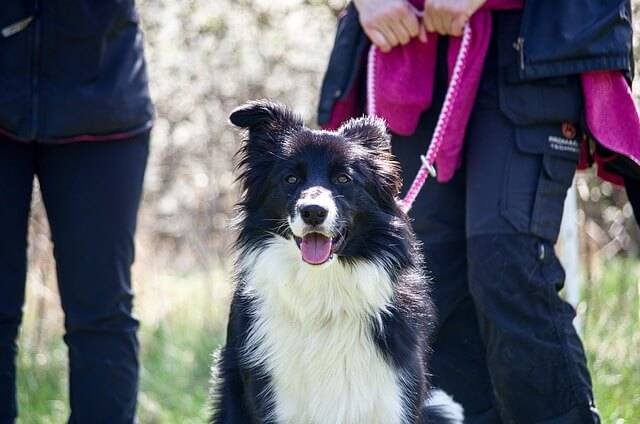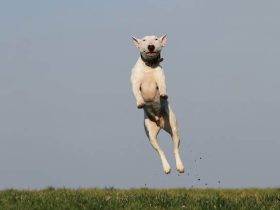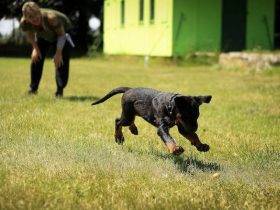The importance of leash training for puppies
Leash training a puppy is a crucial aspect of your puppy’s development. Not only does it provide exercise and mental stimulation, but it also ensures the safety of your furry friend and those around you. When properly trained, your puppy will be able to walk on a leash without pulling or becoming overly excited. This article will guide you through the process of leash training your puppy, step by step, so that you both can enjoy peaceful and enjoyable walks together.
Understanding the basics of leash training a puppy
Before embarking on the journey of leash training a puppy, it’s important to understand the basics. A leash is a tool that connects your puppy to you, providing control and guidance during walks. It’s essential to choose the right type of leash that suits your puppy’s size and strength. A standard leash with a length of 4 to 6 feet is recommended for most puppies. Additionally, a properly fitting collar or harness will ensure comfort and prevent any harm to your puppy’s neck.
Getting started with leash training a puppy
To begin leash training a puppy, introduce your puppy to the leash in a positive and calm manner. Allow them to sniff and investigate the leash before attaching it to their collar or harness. Start by letting your puppy walk around with the leash dragging behind them, gradually increasing the time spent wearing it. This will help them get used to the sensation and weight of the leash. Reward your puppy with treats and praise for their cooperation.
Next, it’s time to practice walking with your puppy on the leash. Start in a quiet and familiar environment, such as your backyard or a quiet park. Hold the leash loosely and encourage your puppy to walk beside you. If they start to pull or become distracted, gently redirect their attention back to you. Use positive reinforcement, such as treats and praise, to reward your puppy for walking calmly on the leash. Remember to be patient and consistent during this process.
Step-by-step guide to leash training your puppy
- Establish a routine: Set a consistent schedule for leash training sessions. This will help your puppy understand when it’s time for a walk and what is expected of them.
- Start indoors: Begin leash training indoors, where there are fewer distractions. Use treats and toys to motivate your puppy and encourage them to walk beside you.
- Gradually move outdoors: Once your puppy is comfortable walking on a leash indoors, gradually transition to outdoor environments. Start in a quiet area and gradually expose them to busier and more stimulating environments.
- Practice basic commands: Incorporate basic commands such as “sit” and “stay” into your leash training sessions. This will help your puppy understand that they need to listen to you even when they are excited or distracted.
- Reward good behavior: Whenever your puppy walks calmly on the leash without pulling or becoming overly excited, reward them with treats and praise. Positive reinforcement will strengthen their leash walking skills.
- Be patient: Leash training takes time and patience. Remember to stay calm and consistent with your training efforts. Celebrate small victories and don’t get discouraged by setbacks.
Common challenges in leash training a puppy and how to overcome them
Leash training a puppy can sometimes present challenges, but with the right leash training approach, these obstacles can be overcome. Here are some common challenges and how to address them:
- Pulling: If your puppy tends to pull on the leash, try changing directions whenever they start to pull. This will teach them that pulling doesn’t lead to forward progress. Reward them when they walk calmly beside you.
- Distractions: Puppies are naturally curious and easily distracted. If your puppy becomes fixated on something during a walk, use treats or a toy to redirect their attention back to you.
- Fear or anxiety: Some puppies may exhibit fear or anxiety when wearing a leash or being outside. Gradually introduce them to the leash and outdoor environment, using positive reinforcement to build their confidence.
- Excitement: If your puppy becomes overly excited during walks, practice calm and controlled behaviors. Reward them for walking calmly and redirect their energy into appropriate outlets, such as playing with a toy.
Tips for successful leash training your puppy
To ensure successful leash training for your puppy, consider the following tips:
- Consistency: Stick to a regular training schedule and be consistent with your commands and expectations.
- Positive reinforcement: Reward your puppy with treats, praise, and affection when they exhibit good leash walking behavior.
- Short training sessions: Keep training sessions short and enjoyable for your puppy. Gradually increase the duration as they become more comfortable.
- Stay calm: Your puppy can pick up on your emotions, so it’s important to stay calm and patient during training sessions.
- Socialization: Use leash training as an opportunity to expose your puppy to different environments, people, and animals. This will help them become well-rounded and confident.
Introducing loose leash walking
Once your puppy has mastered basic leash walking, you can introduce the concept of loose leash walking. Loose leash walking means that your puppy walks beside you with a relaxed leash, without pulling or dragging.
To teach loose leash walking, start by using a verbal cue such as “let’s go” or “walk nicely.” Begin walking and reward your puppy for staying close to you with treats and praise. If they start to pull, stop walking and wait for them to return to your side. Resume walking when the leash is loose again. Consistency and positive reinforcement will help your puppy understand the desired behavior.
Techniques to teach your puppy loose leash walking
There are several techniques you can use to teach your puppy loose leash walking:
- Stop and start: Whenever your puppy starts to pull on the leash, stop walking and wait for them to return to your side. Reward them when they do, and then continue walking. This teaches them that pulling doesn’t lead to forward progress.
- Change directions: If your puppy starts to pull, quickly change direction. This will catch them off guard and teach them to pay attention to your movements.
- Use treats for focus: Hold treats close to your body and use them to guide your puppy’s attention back to you. Reward them when they walk beside you with a loose leash.
- Practice in different environments: Gradually expose your puppy to different environments and distractions while practicing loose leash walking. Start in a quiet area and gradually increase the level of difficulty.
Reinforcing good leash walking behaviors
Consistency is key when it comes to reinforcing good leash walking behaviors. Here are some strategies to reinforce positive behaviors:
- Reward frequently: Initially, reward your puppy frequently for walking calmly on the leash. As they improve, gradually reduce the frequency of treats, but continue to offer praise and affection.
- Use verbal cues: Introduce verbal cues such as “walk nicely” or “let’s go” to signal to your puppy that they are exhibiting the desired behavior.
- Be patient: Remember that learning takes time, so be patient with your puppy as they learn to walk on a loose leash.
Troubleshooting leash training issues
If you encounter specific issues during leash training, here are some troubleshooting tips:
- Pulling towards other dogs: If your puppy pulls towards other dogs, practice the “look at me” command. Encourage your puppy to make eye contact with you and reward them when they do.
- Pulling towards people or objects: If your puppy pulls towards people or objects, redirect their attention by using treats or a toy. Reward them for focusing on you instead.
- Fearful or skittish behavior: If your puppy exhibits fear or skittish behavior during leash training, consult a professional dog trainer for guidance. They can help you address any underlying issues and provide specialized dog training techniques.
Leash training tools and equipment
While a standard leash and collar or harness are the basic tools needed for leash training, there are additional tools that can aid in the process. These include:
- Front-clip harness: A front-clip harness attaches the leash to the front of your puppy’s chest, providing more control and discouraging pulling.
- Head halter: A head halter fits over your puppy’s snout and allows you to control their head movements. This can be useful for puppies who are strong pullers.
- Long line: A long line is a longer leash that gives your puppy more freedom to explore while still under your control. This can be helpful during the transition to off-leash walking.
Conclusion
Leash training is an essential skill for any puppy to learn. It provides exercise, mental stimulation, and ensures their safety and the safety of those around them. By following this step-by-step guide and implementing the tips and techniques mentioned, you can successfully leash train your puppy and enjoy peaceful walks together. Remember to be patient, consistent, and reward good behavior. Happy walking!
CTA: Now that you have the knowledge and tools to leash train your puppy, put it into practice! Start today and enjoy the benefits of a well-behaved and happy walking companion.





Leave a Reply